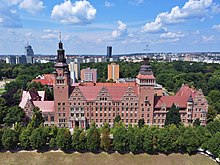Szczecin
The city is situated along the southwestern shore of Dąbie Lake, on both sides of the Oder and on several large islands between the western and eastern branches of the river.The city's recorded history dates back over 1,300 years, when diverse tribes and peoples such as the Vikings and Lechites erected strongholds in the vicinity.The city's architecture and cultural heritage reflects these periods, with excellent examples of Brick Gothic, Gründerzeit, Neoclassical, socialist realist and contemporary styles.[7] Szczecin and Stettin are the Polish and German equivalents of the same name, which is of Proto-Slavic origin, though the exact etymology is the subject of ongoing research.[19][20] In a campaign in the winter of 1121–1122,[21] Bolesław III Wrymouth, the Duke of Poland, gained control of the region, including the city of Szczecin and its stronghold.[31] During the Wendish Crusade in 1147, a contingent led by the German margrave Albert the Bear, an enemy of Slavic presence in the region,[8] papal legate, bishop Anselm of Havelberg and Konrad of Meissen besieged the town.[44] In the second half of the 12th century, a group of German tradesmen ("multus populus Teutonicorum"[46] from various parts of the Holy Roman Empire) settled in the city around St. Jacob's Church, which was donated in 1180[46] by Beringer, a trader from Bamberg, and consecrated in 1187.[49] Duke Barnim I of Pomerania granted Szczecin a local government charter in 1237, separating the German settlement from the Slavic community settled around the St. Nicholas Church in the neighbourhood of Kessin (Polish: Chyzin).[60] The far-reaching autonomy granted by the House of Griffins was in part reduced when the dukes reclaimed Stettin as their main residence in the late 15th century.[63] Nevertheless, a Landtag that had met in Stettin in 1563 introduced a sixfold rise in real estate taxes to finance the raising of a mercenary army for the duchy's defence.Before the Thirty Years' War reached Pomerania, the city, as well as the entire duchy, declined economically due to the decrease in importance of the Hanseatic League and a conflict between Stettin and Frankfurt an der Oder.[67] When part of the defensive structures were levelled, a new neighbourhood, Neustadt ("New Town") as well as water pipes, sewerage and drainage, and gas works were built to meet the demands of the growing population.[67] Stettin played a major role as an entrepôt in the development of the Scottish herring trade with the Continent, peaking at an annual export of more than 400,000 barrels in 1885, 1894 and 1898.[85] According to German historian Jan Musekamp, the activities of the Polish pre-war organizations were exaggerated after World War II for propaganda purposes.[87] During World War II, Stettin was the base for the German 2nd Motorised Infantry Division, which cut across the Polish Corridor and was later used in 1940 as an embarkation point for Operation Weserübung, Germany's assault on Denmark and Norway.International press reports emerged, describing how the Nazis forced Jews, regardless of age, condition and gender, to sign away all property and loaded them onto trains headed to the camp, escorted by members of the SA and SS.[93] Allied air raids in 1944 and heavy fighting between the German and Soviet armies destroyed 65% of Stettin's buildings and almost all of the city centre, the seaport, and local industries.This would have been in accordance with the Potsdam Agreement between the victorious Allied powers, which envisaged the new border to be in "a line running from the Baltic Sea immediately west of Swinemünde, and thence along the Oder River[...]".[103] While in 1945 the number of pre-war inhabitants dropped to 57,215 on 31 October 1945, the systematic expulsion of Germans started on 22 February 1946 and continued until late 1947, in accordance with the Potsdam Agreement.[98] To ease the tensions between settlers from different regions, and help overcome fear caused by the continued presence of the Soviet troops, a special event was organised in April 1946 with 50,000 visitors in the partly destroyed city centre.At the same time, Szczecin became a major Polish industrial centre and an important seaport (particularly for Silesian coal) for Poland, Czechoslovakia and East Germany.Szczecin has an oceanic climate (Köppen: Cfb) with some humid continental (Dfb) characteristics in normal not updated, typical of Western Pomerania.The city has an abundance of green areas: parks and avenues – wide streets with trees planted in the island separating opposing traffic (where often tram tracks are laid); and roundabouts corresponding to the Orion constellation.[136] The ruins of the former Griffin residence, initially renamed "Piast Palace", also played a central role in this concept[134] and were reconstructed in Renaissance style, with all traces of later eras removed.Babin, Barnucin, Basen Górniczy, Błędów, Boleszyce, Bystrzyk, Cieszyce, Cieśnik, Dolina, Drzetowo, Dunikowo, Glinki, Grabowo, Jezierzyce, Kaliny, Kępa Barnicka, Kijewko, Kluczewko, Kłobucko, Kniewo, Kraśnica, Krzekoszów, Lotnisko, Łasztownia, Niemierzyn, Odolany, Oleszna, Podbórz, Port, os.Przyjaźni, Rogatka, Rudnik, Sienna, Skoki, Słowieńsko, Sosnówko, Starków, Stoki, Struga, Śmierdnica, os.Świerczewskie, Trzebusz, Urok, Widok, Zdunowo.[148] There are a few theatres and cinemas in Szczecin: and many historic places as: The statue, Monument of Sailor stands at the Grunwald Square at John Paul II Avenue.The local cuisine in Szczecin was mostly shaped in the mid-20th century by people who settled in the city from other parts and regions of Poland, including the former Eastern Borderlands.Szczecin has good railway connections with "Solidarity" Szczecin–Goleniów Airport and the rest of Poland, e.g., Świnoujście, Kołobrzeg, Poznań, Wrocław, Warsaw and Gdańsk.Over the long course of its history Szczecin has been a place of birth and of residence for many famous individuals, including Empress Catherine the Great of Russia, composer Carl Loewe, writer Alfred Döblin, actress Dita Parlo, mathematician Hermann Günther Grassmann, Roman Catholic priest Carl Lampert, poet Konstanty Ildefons Gałczyński, Helena Majdaniec – "the queen of Polish Twist", and singer Violetta Villas.There are 15 honorary consulates in Szczecin, of Bosnia and Herzegovina, Cyprus, Czech Republic, Denmark, Estonia, Finland, France, Germany, Italy, Lithuania, Luxembourg, Moldova, Norway, Sweden and Ukraine.




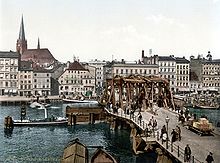

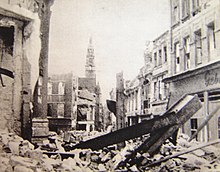







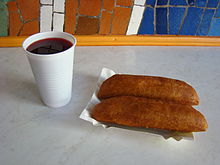

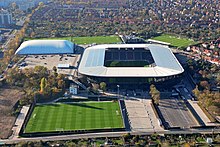




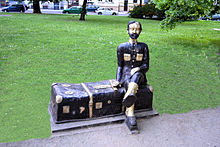

Stettin (disambiguation)Szczecin (disambiguation)SzechuanChrobry EmbankmentNatl. MuseumReg. OfficeHanza TowerOld Town HallSzczecin PhilharmonicArt AcademyOder RiverCathedralCoat of armsBrandmarkCountryPolandVoivodeshipWest PomeranianCountyPiotr KrzystekDemonym(s)Time zoneArea codeCar platesClimateSolidarity Szczecin–Goleniów AirportGermanSwedishcapitalWest Pomeranian VoivodeshipBaltic SeaGerman borderseaportSzczecin LagoonBay of PomeraniaDąbie LakeheathsWkrzańska HeathSzczecin Landscape Parktown of PoliceSzczecin agglomerationGerman statesBrandenburgMecklenburg-Western PomeraniaVikingsLechitesDukes of PomeraniaHouse of GriffinPiast PolandDenmarkSwedenHoly Roman EmpirePrussiaBrick GothicGründerzeitNeoclassicalsocialist realistOrion constellationSzczecin CathedralDucal CastleNational MuseumUniversity of SzczecinPomeranian Medical UniversityMaritime UniversityWest Pomeranian University of TechnologySzczecin Art AcademySzczecin-Kamień Catholic ArchdioceseheadquartersMultinational Corps NortheastEuropean Capital of CultureProto-Slavicfuller's teaselpersonal nameKnytlinga sagaHistory of SzczecinTimeline of SzczecinKashubiansLehiticGriffinWest SlavsPomeraniastrongholdmodern castleOder bankMieszko I of PolandPomerania during the Early Middle AgesMieszko II LambertLiutician federationBolesław III WrymouthOtto of BambergWendish CrusadeAlbert the BearAnselm of HavelbergKonrad of MeissenMieszko III the OldRatibor IBattle of VerchenBogusław I, Duke of PomeraniaHenry the LioncastellanWartislaw IIWładysław III SpindleshanksGreater PolandHigh Duke of PolandCanute VI of DenmarkBattle of BornhövedWolgastBambergSzczecin StrugaOstsiedlungBarnim Ilocal governmentSt. NicholasPolishSzczecin CastleWartislaw IMagdeburg rightsDąbiePomeranianPoznańPrzemysł IILudgardaBarnim I, Duke of PomeraniaWendish townsHanseatic Leagueherring
